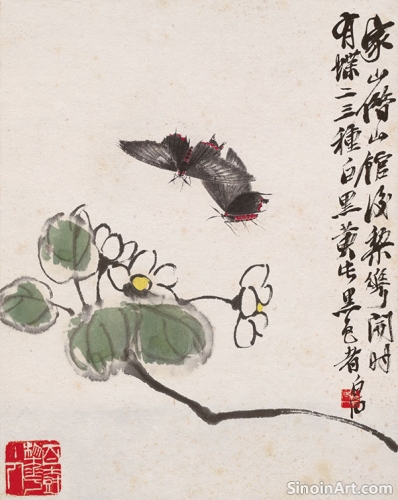Xieyi Painting and the Depiction of Mountains
|
Mountains are a central and symbolic subject in Xieyi painting, often depicted to express a range of emotions, philosophical ideas, and the artist's profound connection to nature. They represent majesty, strength, and timelessness. They are one of the most fundamental and enduring subjects in Chinese painting.  The use of broad washes and suggestive brushstrokes allows the artist to capture the grandeur, scale, and rugged beauty of mountains, creating a sense of depth and atmosphere that draws the viewer into the scene. The washes allow the artist to capture a sense of scale and create a dynamic, atmospheric feeling. This ability to suggest a powerful feeling of being in nature is a key aspect of Xieyi painting.  Different types of brushstrokes, including dry brush, axe-cut strokes, and multiple textures can be used to depict the various surfaces of mountains, from smooth slopes to rocky cliffs. The texture of the mountains is created by a rich combination of different techniques. The subtle variations in texture and line add depth and meaning to the overall composition.  Mountains in Chinese culture often symbolize stability, permanence, and the connection between the human realm and the heavens, and these symbolic meanings add a layer of philosophical depth to the paintings. The mountains offer a source of meditation and philosophical inspiration for the artists. The deeper meaning enriches the viewing experience. Through the depiction of mountains, Xieyi artists also explore the relationship between humans and the natural world, conveying their own emotional responses to the beauty, power, and mystery of the mountainous landscape. The artwork is a vehicle for the artist to communicate their inner feelings and experiences of nature. It reflects a deeply personal connection to the natural world. |
Tag : Mountain painting, Xieyi mountains, Chinese landscapes, ink wash, nature
Related information
- Xieyi Painting and the Expression of Loneliness
- The Concept of "Yi Bi Cheng Qiao" in Xieyi
- The Future of Xieyi Painting
- The Use of "Reversed Brush" in Xieyi
- Xieyi Painting and the Use of "Light Ink"
Xieyi painting powerfully expresses loneliness through suggestive compositions, vast negative space, solitary subjects, muted colors, and a sense of introspection, exploring solitude and the human condition, evoking melancholy and longing, and providing a space for contemplation and self-reflection.
"Yi Bi Cheng Qiao" (skill achieved in one brushstroke) is a key concept in Xieyi, emphasizing precision, confidence, and spontaneity in each brushstroke, aiming for efficiency, expressiveness, and a seemingly effortless display of skill, acquired through dedicated training and a deep connection with the art form.
The future of Xieyi painting is bright, with contemporary artists expanding its boundaries, exploring new mediums, embracing social themes, and sharing their work globally, while the art form's ability to connect emotionally ensures its continued vitality and relevance.
The "Reversed Brush" (nìfēng) in Xieyi involves starting a stroke by moving the brush in the opposite direction, then reversing to create strong, textured, dynamic lines, conveying a sense of force, resistance, and visual interest, while requiring precise control and a deep understanding of brush responsiveness.
"Light Ink" (dànmò) is essential in Xieyi painting, using diluted ink to create subtle tones, soft washes, atmosphere, depth, and delicate transitions, requiring a mastery of brush control, ink dilution, layering, and a delicate touch to convey a sense of quiet beauty.